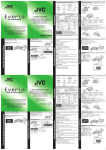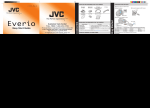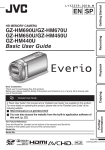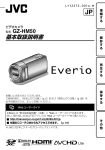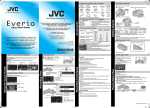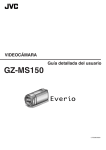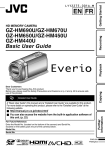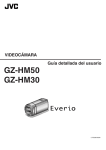Download JVC Everio Gz-hm440aus Full Hd 1080p 2.7" Inch Lcd Touchscreen Camcorder Blue
Transcript
SUPPLIED ACCESSORIES FOR THE CAMERA LYT2259-002A-M AC Adapter AC-V11U USB Cable (Type A - Mini Type B) QAM1313-001 Battery Pack BN-VG114U AV Cable CHARGING THE BATTERY A Close the LCD to turn Off the Power Basic User Guide B Attach the battery C Connect AC adapter into DC connector Cover Optional* • Component Cable (QAM1266-001) Easy Start Guide For more details on operating this product, please refer to the “Detailed User Guide” at the following website: http://manual.jvc.co.jp/index.html/ For additional online video tutorials, please visit: http://camcorder.jvc.com/tutorials.jsp Register your EVERIO online at: REGISTER.JVC.COM and receive a special offer. This easy start guide is designed to navigate you to using your new Everio quickly. Please refer to the owner’s manual for a detailed listing of features. * To order any of these accessories please visit www.JVC.com or call 1-800-858-6442 TYPES OF USABLE SD CARDS Memory Cards* SD Cards 2 3 1 * SD card not included 0:00:00 [0:54] Tap B Tap the desired selection on the touch screen. • Tap or to scroll the pages. Tap Common/Basic (Q) menu The information below will be displayed on the LCD during recording. (Telephoto) Press to Start Recording • Press again to Stop Recording. 9:01PM Battery Indicator Recording Media Remaining Recording Time MENU Video Quality A Open the LCD monitor to turn on the unit. – Always check available memory space and battery power in advance. B Tap L on the touch screen to select the playback mode. 1 2 3 C Press the A/B button on the unit to select the video or still image mode. D Tap on the thumbnail on the index screen to play back. • Tap b or a to scroll the pages. – Look for something you can set your camera on. (Wide angle) 0:00:00 [0:54] Preparation – Look for a place to sit down and take your video. Scene Counter STILL IMAGE RECORDING Press halfway to focus Lights up in green when focused • Selections are also available in the Common/Basic (Q) menu and Face Short Cut ( ) menu. Press fully to take still image Recording Techniques Face Short Cut menu CLOCK ADJUST Label Try these tips to improve the image: Zooming Select an item from the menu screen. A Tap MENU on the touch screen to display the main menu. CAUTION • Be sure to use JVC battery packs. If you use any other battery packs besides JVC battery packs, safety and performance cannot be guaranteed. Stabilizing Your Picture VIDEO RECORDING CHANGING MENU SETTINGS ( ) for models with more than 3M CMOS. • The above are values when “LIGHT” is set to “OFF” and “MONITOR BRIGHTNESS” is set to “3” (standard). Note: The battery pack is not charged at the time of purchase. Open – Make sure your battery is fully charged. MENU MENU Continuous Recording Actual Recording 2 hr. (1 hr. 55 min.) 1 hr. 5 min. (1 hr. 5 min.) 3 hr. 5 min. (2 hr. 55 min.) 1 hr. 40 min. (1 hr. 35 min.) 5 hr. 30 min (5 hr. 20 min.) 3 hr. (2 hr. 55 min.) Bottom – A spare battery may be useful. 0:00:00 [0:54] MENU 4 2011 0:12:34 Panasonic, TOSHIBA, SanDisk, ATP, Eye-Fi* Class 4 or higher compatible SDHC card (4 GB to 32 GB) / Class 4 or higher compatible SDXC card (max. 64 GB) Standard SD Card (256 MB to 2 GB) Standard SDHC Card (4 GB to 32 GB) Standard SDXC Card (max. 64 GB) Eye-Fi Connect X2 / Eye-Fi Explore X2 / Eye-Fi Pro X2 * Only the specified models may be used. Refer to the Detailed User Guide for details. • Using cards other than those specified above may result in recording failure or data loss. • Eye-Fi manufactures SD memory cards with wireless LAN function. 1210ASR-SW-VM Charging Time 2 hr. 30 min. 3 hr. 30 min. 6 hr. 10 min. A Open the card slot cover B Install an SD Card • Turn off the power before inserting or removing an SD card Note: Operations are confirmed on the following SD cards. Manufacturer Video A Battery Type BN-VG114U (Supplied) BN-VG121U BN-VG138U AC Adapter To AC Outlet (110V to 240V) INSERTING THE SD CARD* Refer to the website of Eye-Fi, Inc. Lights up during still image recording 2011 – Consider using a tripod or a monopod to further steady your video. Camera Movement The most enjoyable and professional looking videos generally have very little camera movement – Treat all movements as a special effect. – If you must move the camera, do it slowly. Zooming As a general rule, your video will look better if you zoom the lens before you start your recording: – Focus on the subject first, then begin recording. – If you must zoom during a recording, treat it as a special effect and zoom slowly. Exposure – Remember to shoot with the sun or the primary light source behind you. – Keeping the range of contrast in your scene to a reasonable level is the easiest way to improve the picture quality. – Pay special attention to objects in the LCD screen that appear very washed out or over exposed. – Making a simple change in how the camera is aimed or by zooming in slightly, you may reduce contrast to a reasonable range. Playing Back Files Index Playback Screen Recording Files Using the Touch Screen 0:01:23 – – – – 20 min. 40 min. 1 hr. 20 min. 2 hr. 50 min. 4 hr. 20 min. 5 hr. 50 min. B Still images (1920x1080/FINE) – 400 800 1600 3200 6700 9999 9999 9999 9999 Charging in progress: Blinks Charging finished: Goes out PLAYBACK VIDEOS A Open the LCD monitor to turn on the unit. B Open the lens cover by sliding the switch down. C Verify that the unit is in the recording mode. • If in the playback mode, tap & to switch. • The mode changes between recording and playback with every tap. D Press the A/B button on the unit to select the video or still image mode. The Mode will be displayed in the LCD. Example: Playback Screen 256 MB 512 MB 1 GB 2 GB 4 GB 8 GB 16 GB 32 GB 48 GB 64 GB Connect X2 Explore X2 Pro X2 A Video (UXP) D Connect the AC adapter to outlet RECORDING FILES A Tap the displayed icon button on the touch screen to select the operation. B Tap the thumbnail on the touch screen to select the file. • Depending on the operation, tap, drag or flick on the effective operation area of the touch screen to make selection or to perform an action. Recording Screen Supports 256 MB to 2 GB Supports Eye-Fi Cards wireless <Wi-Fi capability> LAN function Eye-Fi USING THE ICON BUTTONS/THUMBNAILS Capacity Supports SDHC Cards 4 GB to <SD High capacity> 32 GB Still Image B C1B Description • Provides a longer recording time than the battery pack that comes with this unit or it can also be used as a spare battery pack. • Enables the battery pack to be charged without using this unit. SDXC Cards Supports <SD Extended capacity> max. 64 GB JVC U.S.A. A Division of JVC Americas Corp. 1700 Valley Road, Wayne, NJ 07470 www.jvc.com For more details on operating this product, please refer to the “Detailed User Guide” at the following website: http://manual.jvc.co.jp/index.html/ For additional online video tutorials, please visit: http://camcorder.jvc.com/tutorials.jsp Product Name* Battery Pack • BN-VG121U • BN-VG138U Battery Charger • AA-VG1U Getting Started Customer Care Center TOLL FREE 1-800-252-5722 Accessories AVAILABLE ACCESSORIES FOR THE CAMERA PLAYBACK ON A TV Preparation: • Turn off both camera and TV. 䡲 To connect using the HDMI mini connector • When connecting to a 1080p compatible TV, set [HDMI OUTPUT] to [AUTO] DC Connector HDMI Mini Connector 䡲 Playback Operation After the connection with TV is completed, A Turn on the camera and the TV. B Select the TV input switch. C Start playback on the camera. AC Adapter HDMI Cable (Optional) (Mini to full-sized HDMI cable) Length of Recording To AC Outlet Many recordings are ruined by stopping the recording too soon and missing the best moment: – Always try for at least a 10 second recording. – When in doubt, let the recording continue longer. Image Size – It is much easier to edit unneeded material later. Recording Media 9:01PM HDMI Connector TV Battery Indicator Shutter Speed Focus Recording in Progress [6092] Remaining Number of Shots MENU CARGA DE LA BATERÍA ACCESORIOS SUMINISTRADOS CON LA CÁMARA Adaptador de CA AC-V11U Cable USB (tipo A - mini tipo B) QAM1313-001 Batería BN-VG114U Cable AV A Cierre el LCD para apagar la alimentación Guía básica del usuario B Coloque la bateria C Conecte el adaptador de CA al conector de CC Cubierta Opcional* • Cable componente (QAM1266-001) ACCESORIOS DISPONIBLES PARA LA CÁMARA Para detalles sobre cómo operar este producto, consulte la “Guía detallada del usuario” en el siguiente sitio Web: http://manual.jvc.co.jp/index.html/ Para ver más videoguías en línea, visite: http://camcorder.jvc.com/tutorials.jsp Registre su EVERIO en línea en: REGISTER.JVC.COM y recibirá una oferta especial. Esta guía de inicio rápido está diseñada para indicarle cómo utilizar rápidamente su nueva Everio. Consulte el manual de usuario para obtener una lista detallada de funciones. JVC U.S.A. Una división de JVC Americas Corp. 1700 Valley Road, Wayne, NJ 07470 www.jvc.com Para detalles sobre cómo operar este producto, consulte la “Guía detallada del usuario” en el siguiente sitio Web: http://manual.jvc.co.jp/index.html/ Para ver más videoguías en línea, visite: http://camcorder.jvc.com/tutorials.jsp C1B Pantalla de índice de reproducción 0:12:34 2011 0:00:00 [0:54] MENU MENU CAMBIO DE AJUSTES DEL MENÚ Seleccione una opción de la pantalla de menú. A Pulse MENÚ en la pantalla táctil para visualizar el menú principal. Menú de acceso directo a funciones de rostro 0:00:00 [0:54] MENU Pulsar B Pulse la selección deseada en la pantalla táctil. • Pulse o para pasar de una página a la otra. AJUS.RELOJ Pulsar Menú común/básico (Q) • Las selecciones también están disponibles en el menú común/básico (Q) y en el menú de acceso directo a funciones de rostro ( ). Grabación de archivos Utilizar de la pantalla táctil 0:01:23 Capacidad A Vídeo (UXP) B Imágenes fijas (1920x1080/FINA) – 400 800 1600 3200 6700 9999 9999 9999 9999 256 MB – 512 MB – Tarjetas SD 1 GB – 2 GB – 4 GB 20 min. Tarjetas SDHC 8 GB 40 min. Admite 4 GB a <SD de gran 32 GB 16 GB 1 hr. 20 min. capacidad> 32 GB 2 hr. 50 min. 48 GB 4 hr. 20 min. Admite un Tarjetas SDXC <SD de extendida capacidad> máximo de 64 GB 64 GB 5 hr. 50 min. Compatible con Connect X2 Tarjetas Eye-Fi Consulte la página web de función Explore X2 <Capacidad Wi-Fi> Eye-Fi, Inc. inalámbrica LAN Pro X2 Nota: Se ha confirmado el funcionamiento con las siguientes tarjetas SD. Admite 256 MB a 2 GB 1210ASR-SW-VM Zoom (gran angular) (telefoto) Presione este botón para iniciar la grabación • Presione nuevamente para detener la grabación. La información a continuación se visualizará en el LCD durante la grabación. 9:01PM Indicador de batería Grabación de soportes Tiempo restante de grabación MENU Calidad de vídeo Adaptador de CA A salida de CA (110 V a 240 V) Tipo de batería Tiempo de carga Grabación contínua Grabación actual BN-VG114U (suministrado) 2 hr. 30 min. 2 hr. (1 hr. 55 min.) 1 hr. 5 min. (1 hr. 5 min.) BN-VG121U 3 hr. 30 min. 3 hr. 5 min. (2 hr. 55 min.) 1 hr. 40 min. (1 hr. 35 min.) BN-VG138U 6 hr. 10 min. 5 hr. 30 min (5 hr. 20 min.) 3 hr. (2 hr. 55 min.) ( ) para modelos con más de 3M CMOS. • Estos valores corresponden si “ILUMINACIÓN” se ajusta en “OFF” y “BRILLO PANTALLA” se ajusta en “3” (estándar). Nota: La cámara se suministra con la batería descargada. PRECAUCIÓN INTRODUCCIÓN DE LA TARJETA SD* A Abra la tapa de la ranura para tarjetas B Insertar una tarjeta SD • Apague la alimentación antes de introducir o extraer una tarjeta SD Parte de abajo Etiqueta Abierto * Tarjeta SD no incluida REPRODUCCIÓN DE VÍDEO GRABACIÓN DE VIDEO 0:00:00 [0:54] Carga en curso: Parpadea Carga terminada: Se apaga • Asegúrese de utilizar baterías JVC. Si utiliza alguna otra batería que no sea de JVC, no se puede garantizar la seguridad ni el rendimiento. Panasonic, TOSHIBA, SanDisk, ATP, Eye-Fi* Tarjeta SDHC compatible de clase 4 o superior (de 4 GB a 32 GB) / Tarjeta SDXC compatible de clase 4 o superior (máximo de 64 GB) Imagen fija B Tarjeta SD estándar (256 MB a 2 GB) Tarjeta SDHC estándar (4 GB a 32 GB) Tarjeta SDXC estándar (máx. 64 GB) Eye-Fi Eye-Fi Connect X2 / Eye-Fi Explore X2 / Eye-Fi Pro X2 * Sólo pueden utilizarse los modelos especificados. Consulte la Guía detallada del usuario para obtener detalles. • El uso de otras tarjetas que no sean las indicadas anteriormente puede provocar una falla en la grabación o la pérdida de datos. • Eye-Fi fabrica tarjetas de memoria SD con función de LAN inalámbrico. A Abra la pantalla LCD para encender la unidad. 2 3 4 B Abra la cubierta de la lente deslizando el interruptor hacia abajo. 1 C Verifique que la unidad se encuentre en modo de grabación. • En el modo de reproducción, pulse & para cambiar. • El modo cambia entre grabación y reproducción con cada pulsación. D Presione el botón A/B de la unidad para seleccionar el modo video o imagen fija. En el LCD aparecerá el modo. Ejemplo: Pantalla de reproducción Tarjetas de memoria* GRABACIÓN DE ARCHIVOS A Pulse el botón de ícono que aparece en la pantalla táctil para seleccionar la operación. B Pulse la vista en miniatura en la pantalla táctil para seleccionar el archivo. • Dependiendo de la operación, pulse, arrastre o roce ligeramente en la zona efectiva de operación de la pantalla táctil para seleccionar o realizar una acción. Pantalla de grabación TIPOS DE TARJETAS SD UTILIZABLES Contador de escenas GRABACIÓN DE IMÁGENES FIJAS Presione hasta la mitad para realizar el enfoque Se ilumina en verde cuando se ha centrado Presione completamente para tomar una imagen fija Se enciende durante la grabación de imágenes fijas A Abra la pantalla LCD para encender la unidad. Preparativos – Siempre compruebe la memoria disponible y la carga de la batería por adelantado. 1 2 3 B Pulse L en la pantalla táctil para seleccionar el modo de reproducción. – Asegúrese de que la batería esté completamente cargada. – Sería útil contar con una batería adicional. C Presione el botón A/B de la unidad para seleccionar el modo video o imagen fija. Estabilización de la imagen Intente seguir estos consejos para mejorar la imagen: – Busque un lugar donde sentarse y grabe su video. – Busque un lugar en el que pueda colocar la cámara. – Tenga en cuenta el uso de un trípode o monópode para que su video no tenga imágenes movidas. Movimiento de la cámara Los mejores videos y más profesionales generalmente tienen poco movimiento de la cámara – Considere los movimientos como efectos especiales. – Si es absolutamente necesario mover la cámara, hágalo lentamente. Zoom Como regla general, su video será mejor si realiza zoom sobre la lente antes de iniciar la grabación: – Enfoque el sujeto en primer lugar y luego inicie la grabación. – Si debe realizar zoom durante una grabación, considérelo como si fuera un efecto especial y hágalo lentamente. Exposición – Recuerde que debe filmar con el sol o la fuente primaria de luz por detrás suyo. – Si mantiene el rango de contraste de su escena en un nivel razonable, será más fácil mejorar la calidad de la imagen. – Preste especial atención a los objetos en la pantalla LCD que se vean mal o sobreexpuestos. – Si realiza un simple cambio en la forma en que se enfoca la cámara o acercando la imagen suavemente, es posible que se reduzca el contraste hasta un rango razonable. Longitud de la grabación Muchas grabaciones se ven estropeadas porque se detiene la grabación muy repentinamente o porque falta captar el mejor momento: Reproducción de archivos UTILIZAR LOS BOTONES DE ÍCONO/VISTAS EN MINIATURA * Para solicitar algunos de estos accesorios, visite www.JVC.com o llame al 1-800-858-6442 D Conecte el adaptador de CA en el tomacorriente Fabricante Vídeo A Técnicas de grabación Guía de inicio rápido Descripción • Proporciona un tiempo de grabación más prolongado que la batería que viene con esta unidad o también se puede utilizar como batería adicional. • Permite que la batería se cargue sin usar esta unidad. Introducción Centro de atención al cliente NÚMERO GRATUITO 1-800-252-5722 Accesorios Nombre del producto* Batería • BN-VG121U • BN-VG138U Cargador de batería • AA-VG1U D Pulse sobre la vista en miniatura en la pantalla de índice para reproducir. • Pulse b o a para pasar de una página a la otra. 2011 REPRODUCCIÓN EN UN TELEVISOR Preparativos: • Apague la cámara y el televisor. 䡲 Para conectar la unidad utilizando el mini conector HDMI • Al conectar a una televisión 1080p compatible, ajuste [SALIDA HDMI] a [AUTO] Conector de CC Mini conector HDMI 䡲 Operación de reproducción Luego de que la conexión a la televisión se haya completado, A Encienda la cámara y el televisor. B Seleccione el interruptor de entrada del televisor. C Inicie la reproducción en la cámara. Adaptador de CA Cable HDMI (opcional) (cable HDMI tamaño mini a completo) A salida de CA – Intente siempre grabar al menos 10 segundos. Tamaño de imagen Grabación de soportes – En caso de dudas, continúe grabando unos segundos más. – Es mucho más fácil editar posteriormente el material que no se necesita. 9:01PM Conector HDMI TV Indicador de batería Velocidad del obturador Enfoque Grabación en curso [6092] Número restante de tomas MENU 1B_QSG_EN-ES.indd 1 11/15/2010 4:48:06 PM KEEP IT HIGH DEFINITION (Windows) Preparation: To COMPONENT Connector TV Component Cable (Optional) AV Component Video Input Green Y Blue CB/PB To AV Connector Red CR/PR Do not connect the yellow plug when using component cable. Yellow AV Cable (Provided) White Video Input Video Input Audio Input (L) Red Audio Input (R) 䡲 Playback Operation After the connection with TV is completed, A Turn on the camera and the TV. B Select the TV input switch. C Start playback on the camera. For customers with a Blu-ray Player: The provided JVC software lets you create high definition AVCHD discs using standard blank DVD-R media, and your Windows PC with DVD Burner. An AVCHD disc is a great choice because it contains the original HD video, which can be stored on inexpensive blank DVD-R media. These discs can be played back in virtually any recent Blu-ray player that has the AVCHD logo. MAKE A DVD OR VHS (NO PC REQUIRED!) It’s easy to connect a JVC HD Everio to a traditional DVD Recorder or VHS Recorder. UPLOAD TO YouTube™ YouTube™ is a great way to share your videos, in either HD or SD quality. JVC makes it easy. WORKING WITH Apple JVC HD Everio camcorders also work great with Apple. There are a few things to check for best results. Each of these solutions is explained in detail in the following sections. Everio MediaBrowser (Windows) To DC Connector Archive & Share Overview Playing Back Files (cont.) 䡲 To connect using the COMPONENT/AV connector • Change the settings in [COMPONENT OUTPUT]/[VIDEO OUTPUT] according to the connection. • Everio MediaBrowser uses a Calendar based interface that makes it easy to find any video you have recorded by selecting the appropriate date. Everio MediaBrowser is included with your camcorder. It lets you archive and organize your videos. It also lets you create discs and upload video to YouTube™, and other popular web sites. Back up to a computer The provided JVC software also makes it easy to copy your videos to a computer. • Turn off both camera and TV. INSTALL Everio MediaBrowser (Windows) (cont.) INSTALL Everio MediaBrowser (Windows) Preparation: • Turn off the camera by pressing the B button for about 2 seconds. • Connect the camera to the PC with the USB cable. To USB Connector On the camera: A Turn on the camera by pressing the B button for about 2 seconds. B Tap [CONNECT TO PC] on the camera’s touch screen. C Tap [PLAYBACK ON PC] on the camera’s touch screen. To DC Connector USB Cable (Provided) CONNECT TO PC To USB Connector PLAYBACK ON PC AC Adapter To AC Outlet (110V to 240V) On the PC: To USB Connector D Perform the following steps on the computer. A Click “Run INSTALL.EXE” in the auto play dialog box. B Click “Continue” on the user account control screen. • “Software Setup” appears after a while. • If it doesn’t appear, double-click [JVCCAM_APP:] in “My Computer” then double-click [INSTALL.EXE]. E Click [Everio MediaBrowser 3]. • Follow the on-screen instructions. F Click [Next]. USB Menu Operations PLAYBACK ON A TV (CONT.) USB MENU OPERATIONS By connecting a USB cable between this unit and your computer, you can perform operations such as file backups to PC/disc or file uploads to file-sharing site using your computer. Preparation: • Install the Everio MediaBrowser software onto the PC. • Turn off the camera by pressing the B button for about 2 seconds. • Connect the camera to the PC with the USB cable. Refer to the connection diagram in the “INSTALL Everio MediaBrowser (Windows)” section. A Turn on the camera by pressing the B button for about 2 seconds. C The [CONNECT TO PC] menu B The [SELECT DEVICE] menu appears. Tap an option that best suits appears. Tap [CONNECT TO PC] your needs. on the camera’s touch screen. • Tap [CONNECT TO OTHER] if the camera is connected to a device other than a computer. CONNECT TO PC SELECT DEVICE SELECT DEVICE TYPE TO CONNECT CONNECT TO PC CREATE DISC CONNECT TO OTHER DIRECT DISC UPLOAD Option PLAYBACK ON PC G Click [Finish]. • Everio MediaBrowser icons are created on the desktop. PLAYBACK ON PC CREATE DISC DIRECT DISC UPLOAD BACK UP Usage • To play back your recordings on the PC. • To back up your recordings on the PC without using the provided software. • To save your recordings on a disc. • To save all unsaved recordings on a disc. • To upload videos to file-sharing sites. • To back up recordings on the PC. For detailed operations on the above options, refer to the other sections in this guide or the “Detailed User Guide”. CONNECT TO PC To USB Connector BACK UP E Start backup. Saving destination (PC) Click 2 Click VIEW YOUR VIDEO (Windows) • To view video that is still on your camcorder, click on Device>Camcorder in the left side panel of Everio MediaBrowser. • To view video that has already been archived to the computer, click on Library>Calendar and then choose the date the video was recorded. RECORD TO A DVD OR VHS RECORDER • It is also possible to record to a DVD or VHS recorder. Please note that this will create a standard definition recording with standard definition picture quality. Yellow To AV Connector Video Input Video Input White AV Cable (Provided) Audio Input (L) Red Audio Input (R) AC Adapter To AC Outlet (110 V to 240 V) DVD/VHS Recorder To DC Connector Preparation: • Use the supplied AV cable. The yellow connection is video. The white connection is left channel audio. The red connection is right channel audio. Connect this cable to the AV input on your DVD or VHS Recorder. • Follow your DVD/VHS recorder instructions to copy (dub) the video. Note: Choose Settings/Preferences to see the folder where MediaBrowser stores your videos. You can also play back your videos from this folder in most popular media players. • Apague la cámara y el televisor. 䡲 Para conectar la unidad utilizando el conector COMPONENT/AV • Cambie los ajustes a [SALIDA COMPONENTES]/[SALIDA DE VÍDEO] según la conexión. A conector de CC A Conector COMPONENT TV Cable componente (Opcional) Entrada de vídeo componente Verde Y AV Azul CB/PB A conector AV Rojo CR/PR No conecte el enchufe amarillo cuando utiliza un cable componente. Cable AV (proporcionado) Entrada de vídeo Amarillo Entrada de vídeo Blanco Entrada de audio (L) Rojo Entrada de audio (R) 䡲 Operación de reproducción Luego de que la conexión a la televisión se haya completado, A Encienda la cámara y el televisor. B Seleccione el interruptor de entrada del televisor. C Inicie la reproducción en la cámara. Descripción general de archivar & compartir MANTENER EN ALTA DEFINICIÓN (Windows) Preparativos: Reproducción de archivos (cont.) Note: In order to include UXP recordings on your AVCHD discs, be sure to go to Settings>Disc Creation Settings, and under “AVC Disc Creation in UXP mode”, choose “Re-encode to XP mode quality level”. COPIA DE SEGURIDAD DE ARCHIVOS (Windows) En la cámara: A Encienda la cámara presionando el botón B durante unos 2 segundos. B Pulse [CONECTAR A PC] en la pantalla táctil de la cámara. C Pulse [HACER COPIA DE SEGURIDAD] en la pantalla táctil de la cámara. El programa Everio MediaBrowser se inicia en el PC. A conector USB A conector de CC Cable USB (proporcionado) A conector USB Adaptador de CA A salida de CA (110 V a 240 V) CONECTAR A PC HACER COPIA DE SEGURIDAD A conector USB HACER COPIA DE SEGURIDAD En la PC: D Seleccione el volumen. E Inicie la copia de seguridad. Destino de almacenamiento (PC) 1Haga clic Haga clic 2Haga clic VEA SU VIDEO (Windows) 1B_QSG_EN-ES.indd 2 • Para ver un video que aún se encuentra en su videocámara, haga clic en Dispositivo>Videocámara en el panel izquierdo de Everio MediaBrowser. • Para ver un archivo que ya ha sido archivado en la computadora, haga clic en Biblioteca>Calendario y luego seleccione la fecha en la que el video fue grabado. Nota: Seleccione Configuración(S)/Preferencias (S) para ver la carpeta donde MediaBrowser almacena sus videos. También puede reproducir sus videos desde esta carpeta en los reproductores más populares. Trouble with Uploading Videos • Check if you have created an account with YouTube™. Trouble with Using the Provided Software Everio MediaBrowser Consult the customer service center below. • Pixela User Support Center Region USA and Canada Europe (UK, Germany, France, and Spain) Other Countries in Europe Asia (Philippines) China Language English English/German/ French/ Spanish English/German/ French/ Spanish English Chinese Phone # +1-800-458-4029 (toll-free) +800-1532-4865 (toll-free) +44-1489-564-764 +63-2-438-0090 10800-163-0014 (toll-free) For details on how to upload to YouTube™, refer to “MediaBrowser Help”. TRADEMARK • Windows® is either registered trademark or trademark of Microsoft Corporation in the United States and/or other countries. • Macintosh is a registered trademark of Apple Inc. • iMovie and iPhoto are trademarks of Apple Inc., registered in the U.S. and other countries. • YouTube and the YouTube logo are trademarks and/or registered trademarks of YouTube LLC. Para clientes con reproductor de Blu-ray: El software JVC proporcionado le permite crear discos AVCHD de alta definición utilizando medios estándar de DVD-R en blanco, y su PC con Windows y grabadora de DVD. Un disco AVCHD es una gran elección porque contiene el video original en HD, el cual puede ser almacenado en económicos medios de DVD-R. Estos discos pueden reproducirse en casi cualquier reproductor de Blu-ray que incluya el logo de AVCHD. Preparativos: • Apague la cámara presionando el botón B durante unos 2 segundos. • Conecte la cámara al PC con el cable USB. Es sencillo conectar un JVC HD Everio a una grabadora de DVD o de VHS tradicional. CARGAR A YouTube™ YouTube™ es una forma grandiosa de compartir videos, ya sea en calidad HD o SD. JVC hace que sea sencillo. TRABAJAR CON Apple Las videocámaras de JVC HD Everio también funcionan muy bien con Apple. Sólo hay unos pequeños detalles para obtener mejores resultados. Cada una de estas soluciones son explicadas en detalles en las siguientes secciones. To USB port iMovie and iPhoto You can import files from this unit to a computer using Apple’s iMovie ‘08, ‘09, ‘11 (video) or iPhoto (still image). To verify the system requirements, select “About This Mac” from the Apple menu. You can determine the operating system version, processor and amount of memory. Note: • For the latest information on iMovie or iPhoto, refer to the Apple website. • For details on how to use iMovie or iPhoto, refer to the help file of the respective software. • There is no guarantee that the operations will work with all computer environments. SIMPLE FILE BACKUP WITH A Mac Preparation: • Make sure that enough space is left in the Mac’s HDD. • Turn off the camera by pressing the B button for about 2 seconds. • Connect the camera to the Mac Computer with the USB cable. A Turn on the camera by pressing the B button for about 2 seconds. B Tap [CONNECT TO PC] on the camera’s touch screen. To USB Connector C Tap [PLAYBACK ON PC] on the camera’s touch screen. CONNECT TO PC To USB port PLAYBACK ON PC INSTALAR Everio MediaBrowser (Windows) (cont.) Everio MediaBrowser se incluye con su videocámara. Le permite archivar y organizar sus videos. También le permite crear discos y cargar videos en YouTube™, y otros sitios Web populares. CREAR UN DVD O UN VHS (¡NO SE REQUIERE PC!) To USB Connector D Copy and paste the files to the Mac Computer for backup. Realice una copia de seguridad en la computadora El software JVC proporcionado también hace más sencilla la copia de sus videos a una computadora. • Everio MediaBrowser utiliza una interfaz basada en un calendario que facilita encontrar cualquier video que usted haya grabado al seleccionar la fecha correspondiente. A conector USB En la cámara: A Encienda la cámara presionando el botón B durante unos 2 segundos. B Pulse [CONECTAR A PC] en la pantalla táctil de la cámara. C Pulse [REPRODUCIR EN PC] en la pantalla táctil de la cámara. A conector de CC Cable USB (proporcionado) A conector USB CONECTAR A PC REPRODUCIR EN PC Adaptador de CA A salida de CA (110 V a 240 V) A conector USB En la PC: D Siga los siguientes pasos en la computadora. A Haga clic en “Ejecutar INSTALL.EXE” del cuadro de diálogo de reproducción automática. B Haga clic en “Continuar” de la pantalla de control de cuenta de usuario. • Aparecerá “Software Setup” (instalación de software) luego de un momento. • Si no aparece, haga doble clic [JVCCAM_APP:] en “Mi PC” y luego doble clic en [INSTALL.EXE]. E Haga clic en [Everio MediaBrowser 3]. • Siga las instrucciones que aparecen en pantalla. F Haga clic en [Siguiente]. OPERACIONES DEL MENÚ USB Al conectar un cable USB entre esta unidad y su computadora, usted podrá realizar operaciones tales como copias de seguridad de archivos a una PC/disco o cargas de archivos a sitios de intercambio de archivos utilizando su computadora. Preparativos: • Instale el software Everio MediaBrowser en el PC. • Apague la cámara presionando el botón B durante unos 2 segundos. • Conecte la cámara al PC con el cable USB. Consulte el diagrama de conexión en la sección “INSTALAR Everio MediaBrowser (Windows)”. A Encienda la cámara presionando el botón B durante unos 2 segundos. B Aparece el menú [SELECCIONAR C Aparece el menú [CONECTAR A PC]. DISPOSITIVO]. Pulse [CONECTAR A Pulse la opción que mejor se ajuste a PC] en la pantalla táctil de la cámara. sus necesidades. • Pulse [CONECTAR A OTROS] si la cámara está conectada a un dispositivo que no sea una computadora. SELECCIONAR TIPO DE DISPOSITIVO PARA CONECTAR CONECTAR A PC REPRODUCIR EN PC CREAR DISCO CONECTAR A OTROS DISCO DIRECTO CARGAR Opción REPRODUCIR EN PC CREAR DISCO G Haga clic en [Finalizar]. • Los íconos de Everio MediaBrowser aparecerán creados en su escritorio. CONECTAR A PC SELECCIONAR DISPOSITIVO DISCO DIRECTO CARGAR HACER COPIA DE SEGURIDAD Uso • Para reproducir sus grabaciones en una PC. • Para hacer una copia de seguridad de sus grabaciones en su PC sin utilizar el software provisto. • Para guardar sus grabaciones en un disco. • Para guardar todas las grabaciones no guardadas en un disco. • Para cargar videos en sitios de intercambio de archivos. • Para hacer copias de seguridad de sus grabaciones en una PC. Para operaciones detalladas sobre las opciones mencionadas anteriormente, consulte las demás secciones de esta guía o la “Guía detallada del usuario”. CÓMO CARGAR UN ARCHIVO (CLIP DE VIDEO) A YouTube™ (Windows) CREACIÓN DE DISCO AVCHD (Windows) Crear un disco o una cinta Preparativos: • Instale el software Everio MediaBrowser en el PC. • Asegúrese de que dispone de suficiente espacio libre en el disco duro de la PC. • Apague la cámara presionando el botón B durante unos 2 segundos. • Conecte la cámara al PC con el cable USB. Click on the “YouTube™” button. Select the video clips you wish to include. Enter account and upload information. Start upload to YouTube™. INSTALAR Everio MediaBrowser (Windows) Everio MediaBrowser (Windows) 1 Click Click on the “Create Disc” button. Select the video clips you wish to include. Choose a menu background and enter a menu title. Create the AVCHD disc. A B C D Operaciones del menú USB AC Adapter To AC Outlet (110V to 240V) A B C D Preparation: • Install the software on your PC. Working with Apple Preparation: • Install the software on your PC. To USB Connector • You may use the software supplied with the Mac Computer to view and edit files from the Everio Camera. • Connect the Everio Camera to the Mac Computer using a USB Cable. Note: Files must be transferred to the Mac Computer for editing. • Everio MediaBrowser hace posible la creación de discos AVCHD para archivar sus grabaciones en su alta definición original. • Usted puede utilizar cualquier disco estándar de DVD-R, DVD-RW, DVD+R o DVD+RW. • Las grabaciones se graban sin pérdida de calidad. Las grabaciones efectuadas en el modo UXP se convierten primero al modo XP y luego se graban. • Un disco estándar de 4,7 GB tendrá aproximadamente 35 minutos de video en la calidad más alta. • Los discos AVCHD pueden reproducirse en cualquier reproductor de Blu-ray que sea compatible con AVCHD. Sólo busque el logo de AVCHD. Preparativos: • Instale el software en el PC. A Haga clic en el botón “Crear disco”. B Seleccione los clips de video que desea incluir. C Seleccione un fondo de menú e ingrese un título de menú. D Cree un disco de AVCHD. Nota: Para incluir las grabaciones UXP en sus discos AVCHD, asegúrese de dirigirse a Configuraciones>Ajustes de creación de discos, y bajo “Creación de disco AVCHD en el modo UXP”, seleccione “Recodificar al nivel de calidad del modo XP”. GRABAR A UNA GRABADORA DE DVD O VHS • También es posible grabar a una grabadora de DVD o VHS. Tenga en cuenta que esto creará una grabación de definición estándar con calidad de imagen en definición estándar. Verde A conector AV Entrada de vídeo Entrada de vídeo Azul Cable AV (proporcionado) Rojo Adaptador de CA A salida de CA (110 V a 240 V) A conector de CC Entrada de audio (L) Entrada de audio (R) Grabadora de DVD/VHS Preparativos: • Utilice el cable AV proporcionado. La conexión amarilla es el video. La conexión blanca es el canal izquierdo de audio. La conexión roja es el canal derecho de audio. Conecte este cable a la entrada AV de su grabadora de DVD o VHS. • Siga las instrucciones de su grabadora de DVD/VHS para copiar el video. TRABAJAR CON iMovie y iPhoto • Es posible utilizar el software suministrado con el PC Mac para ver y editar archivos desde la cámara Everio. • Conecte la cámara Everio al PC Mac utilizando un cable USB. Nota: Los archivos se deben transferir al PC Mac para su edición. Carga de vídeos Puede cargar vídeos en YouTube™ utilizando el software proporcionado “Everio MediaBrowser”. Preparativos: • Instale el software en el PC. A Haga clic en el botón “YouTube™”. B Seleccione los clips de video que desea incluir. C Ingrese a su cuenta de YouTube™ y luego cargue la información. D Comience a cargar en YouTube™. Problemas con la carga de vídeos • Compruebe si ha creado una cuenta con YouTube™. Problemas con el uso del software proporcionado Everio MediaBrowser Consulte con el centro de servicio al cliente a continuación. • Centro de soporte al usuario de Pixela Región Idioma EE.UU. y Canadá Inglés Europa (Reino Unido, Alemania, Francia y España) Inglés/alemán/francés/ español Asia (Filipinas) Inglés/alemán/francés/ español Inglés China Chino Otros países de Europa Número de teléfono +1-800-458-4029 (línea gratuita) +800-1532-4865 (línea gratuita) +44-1489-564-764 +63-2-438-0090 10800-163-0014 (línea gratuita) Para obtener detalles sobre cómo realizar cargas a YouTube™, consulte “Ayuda de MediaBrowser”. MARCA COMERCIAL • Windows® es una marca registrada o una marca comercial de Microsoft Corporation en los Estados Unidos y/o en otros países. • Macintosh es una marca registrada de Apple Inc. • iMovie y iPhoto son marcas comerciales de Apple Inc., registradas en los EE.UU. y demás países. • YouTube y el logo de YouTube son marcas comerciales y/o marcas comerciales registradas de YouTube LLC. Trabajar con Apple USB Cable (Provided) WORKING WITH iMovie & iPhoto Uploading Videos You can upload your videos to YouTube™ using the provided software “Everio MediaBrowser”. Upload to YouTube™ (Windows) To DC Connector On the camera: A Turn on the camera by pressing the B button for about 2 seconds. B Tap [CONNECT TO PC] on the camera’s touch screen. C Tap [BACK UP] on the camera’s touch screen. Everio MediaBrowser starts on the PC. On the PC: D Select the volume. • Everio MediaBrowser makes it possible to create AVCHD discs to archive your recordings in their original high definition quality. • You can use any standard DVD-R, DVD-RW, DVD+R or DVD+RW disc. • Recordings are recorded with no loss in quality. Recordings made in the UXP mode are first converted to the XP mode, and then recorded. • A standard 4.7 GB disc will hold approximately 35 minutes of video in the highest quality setting. • AVCHD discs can be played back in any Blu-ray player that is AVCHD compatible. Just look for the AVCHD logo. To USB Connector Cargar en YouTube™ (Windows) Preparation: • Install the Everio MediaBrowser software onto the PC. • Make sure that enough space is left in the PC’s HDD. • Turn off the camera by pressing the B button for about 2 seconds. • Connect the camera to the PC with the USB cable. REPRODUCCIÓN EN UN TELEVISOR (CONT.) Archivar/ver su video (Windows) HOW TO UPLOAD A FILE (VIDEO CLIP) TO YouTube™ (Windows) AVCHD DISC CREATION (Windows) Make a Disc or Tape Archive/View Your Video (Windows) FILE BACKUP (Windows) A conector USB Al puerto USB iMovie y iPhoto Usted puede importar archivos desde esta unidad a una computadora utilizando iMovie ‘08, ‘09, ‘11 (vídeo) o iPhoto (imagen fija) de Apple. Para corroborar los requisitos del sistema, seleccione “Acerca de esta Mac” en el menú de Apple. Se puede determinar la versión del sistema operativo, procesador y memoria. Nota: • Para obtener información actualizada sobre iMovie o iPhoto, consulte la página web de Apple. • Para obtener información sobre cómo utilizar iMovie o iPhoto, consulte el archivo de ayuda de los programas de software respectivos. • No hay garantía de que las operaciones funcionen en todos los entornos. COPIA DE SEGURIDAD SIMPLE CON UNA Mac Preparativos: • Asegúrese de que dispone de suficiente espacio libre en el disco duro de la Mac. • Apague la cámara presionando el botón B durante unos 2 segundos. • Conecte la cámara al PC Mac con el cable USB. A Encienda la cámara presionando el botón B durante unos 2 segundos. B Pulse [CONECTAR A PC] en la pantalla táctil de la cámara. A conector USB C Pulse [REPRODUCIR EN PC] en la pantalla táctil de la cámara. CONECTAR A PC Al puerto USB REPRODUCIR EN PC D Copie y pegue los archivos a cualquier carpeta del PC Mac para copia de seguridad. 11/15/2010 4:48:08 PM


